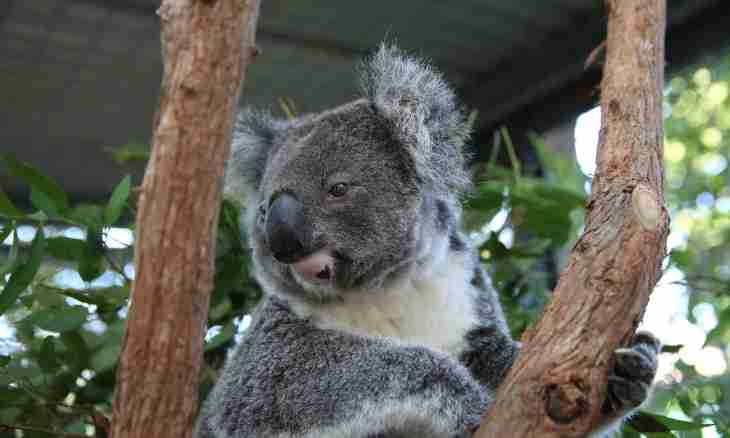Marsupial a bear, or a koala, - a tiny fluffy small animal who lives in Australia. The appearance of this mammal causes affection and admiration. The koala is quite often called a bear cub though she has no relation to this type of animals.
Characteristic and description
Koalas represent small dense small animals which growth fluctuates from 60 to 85 cm, weight is 5-16 kg. Head of these animals big, muzzle flat. Eyes small and widely placed. The ears which are rounded off, shaggy and large, always listening, alerted. Paws of koalas are well adapted for catching and a lasagna, index and big fingers are opposed to the rest, it is convenient to clasp with them branches. Tail of an animal quite small, almost imperceptible.Fur of koalas dense and soft, its color depends on the habitat of an animal therefore can be gray, reddish or red. On a belly wool is always lighter, than on a back. The most outstanding part of a body of a small animal are claws. They are quite powerful. Having stuck them into a tree, the koala will not fall even if will fall asleep (and they sleep sometimes till twenty o'clock in day). Koalas are phlegmatic animals, they can sit for hours on a tree, only occasionally turning the head. Quite often on a back of mom the same unperturbable kid sits. These amusing animals are usually silent, but males let out loud draft cry which can be heard during reproduction at distance in kilometer.
Food and way of lifeKoalas inhabit the eucalyptus woods, carrying out practically all life on crowns. Animals sleep in the afternoon, having nestled on branches, and climb trees in search of a forage at night. On the earth of a koala go down only for transition to other tree to which have no opportunity to jump (though koalas, surprisingly, surely and easily jump). These sluggish and phlegmatic animals for rescue by flight pass to vigorous gallop, quickly climbing up the next eucalyptus tree. Sluggishness of koalas is connected with features of food. Animals adapted to eat only leaves and escapes of an eucalyptus which contain not enough protein, but it is a lot of terpenic and phenolic connections (for the majority of animals they are poisonous). Closer to fall in young escapes hydrocianic acid accumulates. Thanks to poisonous properties of a plant, the food competition at koalas is extremely small. Koalas choose only those types of an eucalyptus which comprise the smaller number of phenolic connections in food and also prefer the trees growing on fertile soil. From 800 types of an eucalyptus marsupials bears eat only 120 types. The developed sense of smell allows koalas to choose suitable food. Daily the animal eats up to 1.1 kg of leaves which it carefully chews and accumulates green material in zashchechny bags. All moisture of a koala is received from leaves of an eucalyptus and dew on them. Small animals drink water only during the periods of a long drought and also during a disease. For completion of deficiency of mineral substances these animals eat the nutritious soil from time to time. The most widespread diseases of koalas: cystitis, conjunctivitis, periostit skulls, sinusitis.
Reproduction
Females adhere to the sites and lead a single life, seldom leave the residence. Males of koalas not territorial, but at a meeting often attack at each other (especially during reproduction) and put mutilations. The period of pairing proceeds from October to February. Animals gather groups which consist of several females and one male (as males is born much less). During this period the males let out loud cries and rub a breast about trees, leaving tags. Pairing between animals happens on trees. Pregnancy of a female lasts on average 30-35 days. In a dung only one cub. At the birth the kid has body length to 18 mm, body weight about 6 gr. The cub is born by a koala in a bag up to six months. Then he travels still the same time on mother's back, having seized fur and eating milk. At the age of 30 weeks the child of a koala begins to eat liquid excrement of mother. At the age of a year he becomes independent and moves off in searches of sites (quite often remain with mothers up to three years). Koalas of times a one or two years breed. Puberty at males comes in 3-4 years, at females – in 2-3 years. There live these animals on average 13 years.

